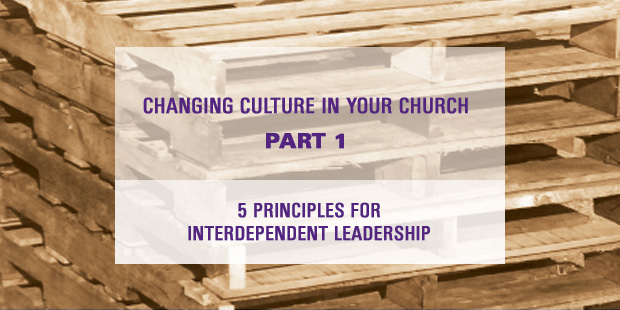
Changing Culture in Your Church, Part 1: 5 Principles for Interdependent Leadership
| What does it take for an organization to set and execute strategy in a complex and interdependent world? Collaborative work across boundaries is increasingly seen as a requirement — but collaboration in most organizations is not a natural act. A shift in thinking, alongside a change in behaviors, is usually needed for genuinely collaborative work. But history and experience suggest that accepted change management techniques are not up to the task of transforming the way we work.What’s needed is a culture change process that combines leadership strategy with the organization’s strategy. Here’s an approach based on five principles.
Principle #1: Culture change is a guided, public-learning process. People cannot simply be “managed” into change. Culture change requires guides who become trusted partners, help steer change and engage in a learning process.Public learning includes truth-telling, revealing mistakes, admission of not having all the answers, and of sharing confusion and even uncomfortable emotions. This is an inside-out experience of our imagination, emotions and human spirit. Executive team members must confront the risks they take and the vulnerability they feel in change that triggers fear, uncertainty and anxiety. But with proper guidance, they can discover that change also holds innovation, creativity and joy. Principle #2: Executives leaders do the change work first. Executives must lead by engagement and example in the transformation process. Senior leaders must own and model the new behaviors before immersing larger numbers of key leaders in the change process. Developing senior leadership’s capability to deal with increasing complexity is core work — not a sideline activity. Principle #3: Develop vertical capability. Dealing with the increased complexity across organizational boundaries requires more mature minds, developing from dependent to independent to interdependent leadership cultures. We call this the vertical framework for changing leadership culture. This allows people to grow increasingly capable of sophistication in the face of complexity. Principle #4: Leadership culture changes by advancing beliefs and practices simultaneously. Best beliefs drive best practices drive best beliefs — like an infinity loop, beliefs and practices are mutual and interdependent. Advancing to a next stage in leadership culture requires developing a self-reinforcing web of beliefs and practices — and our work develops both beliefs and practices in parallel. Principle #5: Sustainable culture change is a learn-as-you-go process embedded in the work of the organization. Leaders need to learn new beliefs by inventing and testing new practices — new ways of working together. Learning is a core practice and culture work is equally important as the work in technical systems and processes. Culture development is the work and not a separate “training exercise.” Based on these five principles, we’ve seen executives, leadership teams and entire organizations “grow bigger minds” — and create an organizational culture capable of learning, changing and succeeding in uncertain, complex times. Coming: Part 2 – 4-Phase Culture-Change Process. Read more from CCL here. |

Tags: Center for Creative Leadership, Change, Staff, Staff Development











